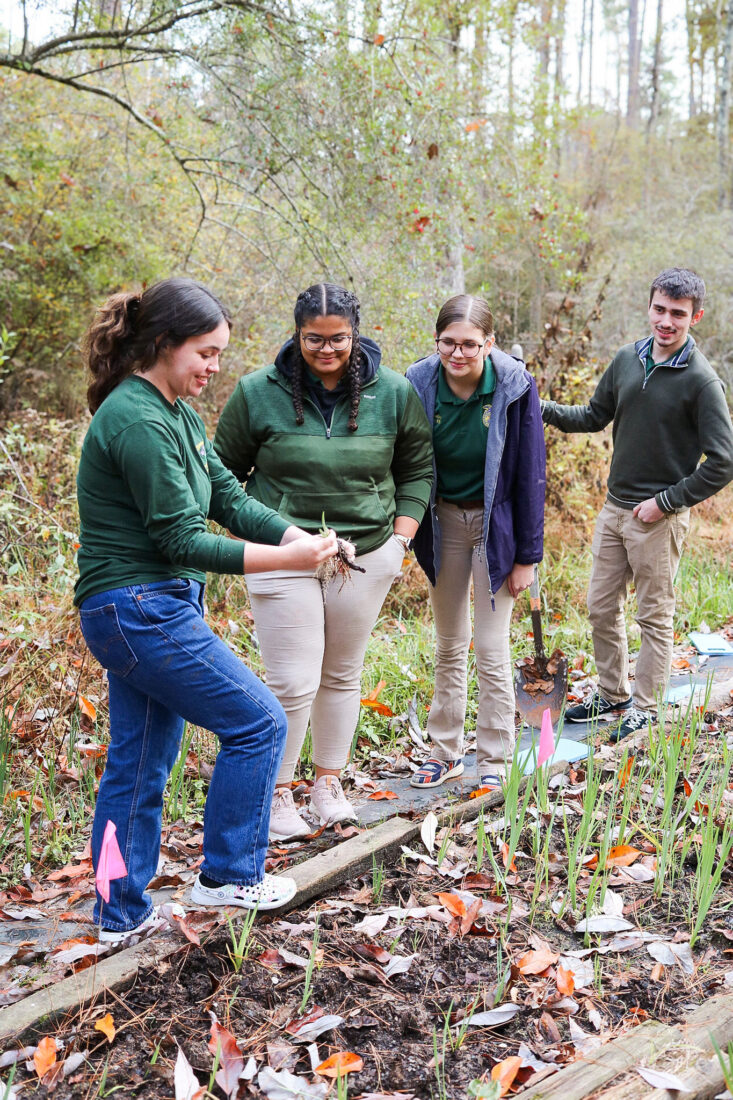There’s a baby girl with enormous eyes like blue marbles strapped beside me in the golf cart. We’re in Saline, Louisiana, a tiny map speck in the sand hills northeast of Natchitoches, about to be whisked through 212 acres of pristine old-growth forest.
I’m momentarily startled. Then enchanted. And finally, curious.

The driver, Bayli Brossette, is mom to this tiny charmer, named Clovis. Turns out rosy-cheeked Clovis accompanies her mother on all her excursions. The year-old tot has become an effective poster child for Briarwood Nature Preserve on social media, and a sought-after plus-one on outings through this secret, wild expanse.
Briarwood dates to 1859 and was the family homestead of Caroline Dormon until it passed after her 1971 death into the hands of her namesake foundation. Dormon was a pioneer—a naturalist, author, artist, and the first woman to be hired by the U.S. Forest Service. She dedicated her life to the conservation of Louisiana’s old-growth forests, and she was instrumental in persuading state and federal leaders to establish Kisatchie National Forest, in which Briarwood sits.
Brossette, twenty-five, is only the third—and by far the youngest—steward of the preserve, appointed in December 2021 after she found the job while scrolling Facebook. Along with her husband, Travis, thirty-one, and Clovis, she lives on site in a 1970s house they’re updating.
“We were a package deal,” Brossette says. “Travis does manual labor, chainsaws, and tractors. I do tours, outreach, and fundraising.” Together, they’re infusing fresh energy into Briarwood, especially into its Bay Garden, which is home to a collection of rare, historic Louisiana irises, including some that date back to the early 1900s.

The Bay Garden sustained extensive damage during a 2019 tornado. Last fall, Brossette began the work of restoring the two-thousand-square-foot garden with the help of some forty-five volunteers, mostly high school students. The volunteers remove soil, plants, and debris from the beds, separating individual iris rhizomes. Next, new soil is enriched with old soil, and the irises are replanted. The final step is fertilization. Mother Nature handles the rest. Brossette is throwing a picnic party to unveil the in-progress garden on April 20, dubbing 2024 “the Year of the Iris.”
“This is delicate work because within the twenty-nine beds, there are more than 150 different cultivars of irises, some only existing at Briarwood,” Brossette explains. “Because the work has to be done when irises are not blooming, we have to make sure those rhizomes stay in their beds to ensure they are not misplaced so we can identify them later on.”

Brossette expects completion of the Bay Garden restoration by 2025. In the meantime, dogwoods, native orchids, mountain laurels, and pitcher plants will bloom in spring, and they are the main attraction at Briarwood. Family-friendly tours are available by appointment year-round and garner a mix of nature-loving folks. Brossette is adding insect, history, and wildlife programs to lure a younger crowd. “Clovis and I are always game for a ride.”

Brossette is a local girl, raised in the nearby woods of Chestnut, who won numerous forestry competitions while a state officer for the Future Farmers of America during high school. Though her college degree is in criminal justice, her heart is now firmly planted at Briarwood. “I don’t plan to leave until I’m too feeble to work,” she says with a laugh.
Clearly, Clovis, like her mom, loves being outdoors. The only time she cried during my ninety-minute tour was when we briefly stepped inside Dormon’s log cabin. Though built in 1951, the primitive structure looks like something from the late 1800s. It houses Dormon’s collection of books, journals, furniture, and paintings.
Dormon lived at Briarwood with her sister, Virginia, from 1917 until both of their deaths decades later. Though she never married nor had children, I think she’d be as captivated as I am by the youthful family ushering in a new era at her beloved home.
Back outside, Clovis quieted, flashing a gummy pink smile at the sun.
Suzanne Wright has written for Arizona Highways, Atlanta Magazine, Hunt & Fish, National Geographic Traveler, and USA Today.








